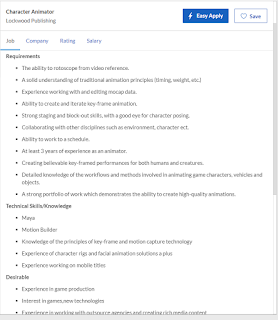Further research and observations
Last week I have met with the specialist tutor from my course and had a chat about what the overall scope for this project is and to what extent can the final artefact be assessed as meeting the criteria given the current circumstances. For example, in my proposal document I am talking about qualifiers such as ‘convincing, compelling or versatile’ animation, albeit the information was never discussed or mentioned on this blog. Additionally, I have not given any particular reason for choosing to animate a bipedal human model either.
As such, in the following blog posts I will be discussing about the questions that I have left unanswered until now, admittedly rushing into the development of the final artefact too soon.
The model
The overall scope of this project is to successfully prepare and animate a biped model in 3D Studio Max. I have chosen to animate a bipedal 3D model based on the results of my research that I have conducted prior to starting the project. Upon checking multiple job adverts where companies or studios were looking for 3D animators, I have noticed that most of them, if not all, were looking for individuals skilled in ‘bringing characters to life with realistic human and animal motion’ or ‘creating believable key-framed performances for both humans and creatures’ or ‘animating the human bipedal figure, as well as other organic forms’ (www.glassdoor.co.uk, 2018), as seen in the adverts below.
 |


Sourcing the model
When choosing the 3D model I had to keep in mind one of the most important aspects, and that was the mesh topology. Because the model represents a human character, it means that in order to create a set of animations its legs, arms, neck, torso and other several parts will need to be translated and rotated as required. In general, a mesh made out of a large amount of polygons is not a problem anymore for modern day’s hardware. However, a model should only be comprised of as many polygons as necessary to reach the desired level of detail. In other words, if a model has 50.000 polygons but the same level of detail could be reached with only 30.000, then the amount of polygons is regarded as unnecessarily high.
The amount of polygons is especially important during the skinning phase, when weight painting the mesh to the bones is required. The more polygons there are in the mesh, the more tedious and time consuming the skinning process gets. Additionally, the polygons must loop around the edges in order to facilitate the animation of the said model. If the polygons don’t loop accordingly around the edges, then the mesh will not deform correctly either, as a result. A good representation of the polygon edge loops can be found in the picture below.
 |
| ('Edgeflow' by Niko Makela) |
In the next blog post I will be discussing about the chosen animation cycles and the 12 crucial animation principles that need to be followed at all times throughout the project.
References:
CGTrader (2010). Edgeflow. [image] Available at: http://www.cgmascot.com/blog/wp-content/uploads/posts/model_loops&flows.png [Accessed 5 Dec. 2018].
Glassdoor.co.uk. (2018). 3D Animator Jobs. [online] Available at: https://www.glassdoor.co.uk/Job/london-3d-animator-jobs-SRCH_IL.0,6_IC267130_KO7,18.htm [Accessed 5 Dec. 2018].


Comments
Post a Comment